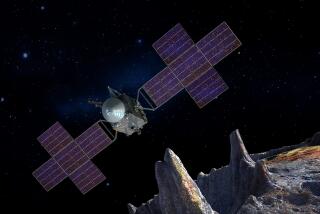Pathfinder Sends Intriguing Images of Mars
- Share via
After triumphantly wobbling down its ramp away from the mother ship Pathfinder, the six-wheeled geologist named Sojourner headed for its first scientific target Sunday: a bicolored, nubby rock named “Barnacle Bill.”
A brief, jerky film of the toddling rover’s descent down its runway evoked whooping and weeping and a sea of raised fists from almost a hundred Pathfinder team members at the Jet Propulsion Laboratory just before midnight Saturday. The rover’s tire tracks left a clear imprint on the floury pink Martian soil.
Screams of “Cook! Cook! Cookie!” filled the packed auditorium as mission manager Robert Cook took the podium.
By Sunday morning, the Imager for Mars Pathfinder camera had already taken a panoramic image of its surroundings, allowing researchers to zero in on interesting targets for study. The camera was scheduled to work through the night taking a 3-D color vista called the “Monster Pan” that will allow the scientists to wander through the rocky Martian terrain remotely with 3-D goggles.
Looking around ther Pathfinder landing site, scientists saw rocks that were rounded and appeared to have been transported by water, and others that were angular, probably ejected by meteor impacts. Most exciting, they found layered bands in the distant hillsides, indicating that the site, the Ares Vallis, had been flooded catastrophically several times.
Scientists speculated that the layers were either terraces cut by erosion or sedimentary deposits. Both geological processes clearly signal the presence of water. Indeed, project scientist Matthew Golombek said that Mars may still harbor oceans of water frozen buried beneath its surface or captured on its northern polar cap.
Researchers said they would try to find out the composition of the individual layers and then try to trace the origins of the layers back to some of the boulders in the foreground.
With the arrival of another Mars spacecraft in September, NASA’s Mars Global Surveyor, researchers will get a much better idea of the overall geology of the planet. “It’s going to take some time to piece it all together,” said Ron Greeley, a geologist from the University of Arizona.
Meanwhile, geologists started doing what any proud new parents would do: naming the newest members of the interplanetary family.
*
One dusty whitish rock became “Casper,” while a flat, dark, reclining figure on the horizon was officially baptized “The Couch.” Camera scientist Peter Smith was so overwhelmed with emotion he said that the joy in his heart had “reached to heaven and to Mars.”
Rover scientist Henry Moore extended what he said were “personal thanks” from the rover Sojourner itself.
“She is the robotic equivalent of Neil Armstrong for Mars,” he said. “She would like to thank all the engineers for getting her there safely and the people of the U.S. and all foreign contributors for paying for her. She is your field geologist.”
Researchers were intrigued by “Barnacle Bill” because it has two distinct sides--a red side and a gray side, and appears to be surrounded by a kind of dry moat. The darker, gray surface appears to be native rock, not covered by dust--of particular interest to geologists because it reveals Mars’ true nature. The moat may have been carved by wind or water, said deputy project manager Brian Muirhead--and appeared to be quite unusual.
The rover-sized rock was also appealing because it was nearby. To reach it, Sojourner only needed to pivot 90 degrees around and back up several feet. The rover was scheduled to begin analyzing Barnacle Bill to determine its elementary composition Sunday night.
Weather on Mars was considerably warmer than detected at the Viking landing sites 21 years ago. Winds were very light with cold gusts coming in from the southwest. Temperatures were around minus-8 degrees Fahrenheit, but varied considerably, according to JPL meteorologist Tim Schofield.
Even at its sunniest, Mars does not get as bright as the Earth because it’s so much farther from the sun. And while the winds would amount to only about 1 mph in Earth atmosphere, said Smith, “They’d be enough to ruffle your hair.”
JPL scientists expect to have many more dramatic images of Mars now that the Imager camera was standing up to its full 5 1/2-foot height. Meanwhile, researchers are continuing to give names to the features they see.
One peak with a white stripe running through it is being nicknamed “The Ski Run,” Greeley said. Another big rock was christened “Yogi.”
“It may seem childish [to give names to the rocks],” said Moore, but it is a lot easier than trying to identify them by coordinates.
The rover was named after Sojourner Truth, a black woman who traveled around the country about the time of the Civil War preaching abolition of slavery.
The rover could continue to explore the geology of the Martian surface indefinitely, Muirhead said, since it has 3 watts of radioactive plutonium in its belly for power. But Sojourner must relay its scientific findings through Pathfinder, and the mother ship’s batteries will probably run out within several months.
Then Sojourner would be “like a little lost kitten taking data with no one at home to hear it,” he said. But he said he suspected the exhausted team of scientists would probably give out before their emissary on Mars.






